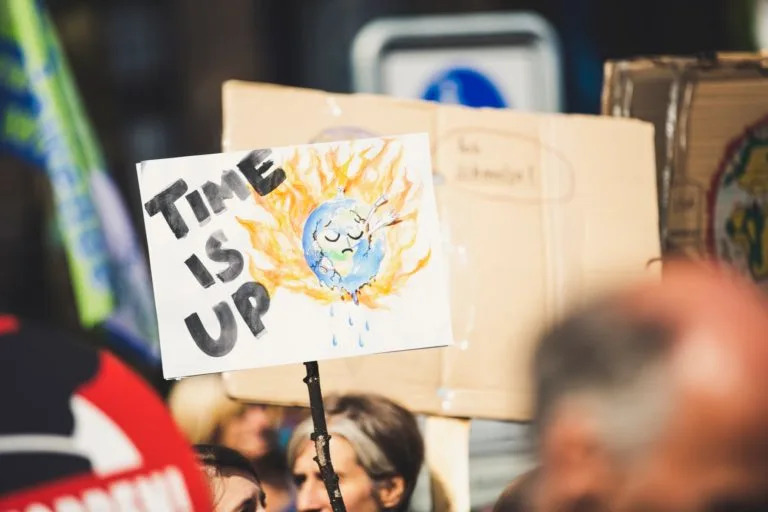This article will look at which countries cause the most climate change owing to their industrial footprint. If you want to skip our overview of the trends in the renewable energy sector, head straight to 8 Countries That Contribute The Most To Climate Change.
Climate change primarily results from human activities that have significantly disrupted the natural balance of our environment. With industrial growth, there was a rise in energy consumption in countries that contribute the most to climate change, leading to significant emissions of greenhouse gases (GHGs) into the atmosphere. These gases trap heat, causing the greenhouse effect.
Another agonizing aspect of climate change is deforestation, as forests are carbon sinks and work as the planet’s lungs. According to the Global Forest Watch, there was a loss of 459 Mha (mega hectare) of tree cover globally between 2001-2022, equivalent to 195 GtCO₂ (gigaton) greenhouse gas emissions.
This large-scale deforestation, whether for timber or to clear land for agriculture, deprives the Earth of its natural carbon filters and these harmful gases reach the ozone layer. Due to such practices, the planet's health is deteriorating, making climate change an urgent threat.
The UN states that GHG emissions are anticipated to increase the planet’s temperature by 1.5°C relative to pre-industrial levels by 2030, which is a critical threshold for Earth. Surpassing this threshold could mean rise in sea levels, more frequent and severe extreme weather events, and disruptions to ecosystems and human societies.
While countries that care about the environment the most prioritize renewable energy sources to reduce climate impact, addressing the issue thoroughly requires the collective efforts of all stakeholders.
Shift Towards Renewables For A Sustainable Future
Growing concerns about climate change, coupled with technological advancements and economies of scale, have placed renewable energy at the forefront of the energy discourse in most major carbon-emitting nations. Countries that traditionally depended on fossil fuels are now turning to renewables to mitigate environmental issues. The International Energy Agency (IEA) projects that global investment in clean energy will amount to $1.7 trillion this year. Likewise, since EVs carbon footprint is smaller (its carbon footprint is indirect because of lithium mining and manufacturing) than conventional internal combustion engines (ICEs) as per the Environmental Protection Agency (EPA), the world's leading automakers plan to invest $1.2 trillion in EV development by 2030.
The proportion of renewable energy in global power generation is consistently increasing, with nations investing in such sources to lessen their reliance on coal, oil, and gas. According to the BP Statistical Review Of World Energy, renewables accounted for almost 13% of power generation in 2021, surpassing nuclear energy (9.8%).
However, despite the known environmental repercussions of coal burning, it remains a significant energy source in mega industries. The coal share in power generation increased from 35% to 36% in 2021, although this was still below its 2019 pre-pandemic level. Most of the Best Coal Mining Stocks to Buy consistently offer dividends and the coal market is expected to grow to a valuation of $658.68 billion by 2027, with a CAGR of 1.4%.
The cost of Solar PV has decreased dramatically, dropping more than 80% since 2010. This reduction has made solar power more accessible. For example, despite being a major carbon emitter due to its coal-based infrastructure, China tops the list of Countries That Produce the Most Solar Energy. Bloomberg notes that China was responsible for over half of the $358 billion invested in solar power in the first half of 2023, leading to an installed capacity of 392 GW, roughly a third of the worldwide total.
Wind power is another renewable source witnessing steady growth, with both onshore and offshore installations becoming more competitive compared to traditional power generation methods in countries with the highest greenhouse gas emissions. For instance, the United States has significantly increased its wind power capacity over the years, reaching 118 GW. The European Union, on the other hand, takes lead in offshore wind installations, particularly on the North Sea coasts of the United Kingdom, Denmark, and the Netherlands.
Prominent electricity companies emphasizing renewables include NextEra Energy, Inc. (NYSE:NEE), First Solar Inc. (NASDAQ:FSLR) and Shell Plc (NYSE:SHEL). NextEra Energy, Inc. (NYSE:NEE) has a diverse renewable energy portfolio covering onshore wind and solar power projects in the US and Canada. In 2020, NextEra Energy, Inc. (NYSE:NEE) 's electricity generation capacity was 55 GW, with over 90% originating from clean or renewable sources.
NextEra Energy's Q2, 2023 earnings call highlighted that its clean energy subsidiary, NextEra Energy Resources (previously known as FPL), saw a 14% year-on-year growth in adjusted earnings for the quarter due to new investments. Energy Resources has experienced strong renewable energy demand, bringing 1,800 megawatts into commercial operations since Q1 2023.
Additionally, the subsidiary added 1,665 megawatts of new renewable and storage projects to the company's backlog. With NextEra Energy's backlog at 20 GW, the company is on course to double its renewable energy portfolio by 2026. NextEra Energy Resources reported a net income of approximately $1.152 billion or $0.57 per share for Q2 2023, marking an increase of $0.07 year-over-year. The company emphasized that solar power remains the most cost-effective option for its customers. This is evident from the 225 megawatts of low-cost solar integrated into the grid in Q2, 2023, raising the total solar additions to 1,200 megawatts. Having commissioned almost 1600 megawatts of new solar generation, the company aims to add about 3,100 megawatts of solar by 2025.
In First Solar Inc.'s (NASDAQ:FSLR) Q2 earnings call, it was announced that the company plans to invest $1.1 billion in the construction of a new, fully vertically integrated manufacturing facility in the US, which will be its fifth facility in the country. The company's recent acquisition of Evolar, a European leader in thin film perovskite and CIGS technology (Copper Indium Gallium Selenide, a semiconductor material used in thin-film solar cells), is set to fast-track its development of next-generation PV technology. By combining Evolar's expertise with First Solar Inc (NASDAQ:FSLR)'s R&D and proficiency in scaling thin film PV, it aims to introduce high-efficiency tandem devices.
Notably, at the end of 2022, Shell Plc (NYSE:SHEL) had 2.2 GW of renewable power in operation, with another 4.2 GW under development. Shell Plc (NYSE:SHEL) 's clean energy portfolio includes onshore & offshore wind farms, solar power plants, and biomass. When other stakeholders in power, transportation, and infrastructure sectors also switch to sustainable fuel alternatives, the climate damage can be significantly curtailed within the next few decades.
Let's now discuss countries that contribute the most to climate change
.

15 Countries That Contribute The Most To Climate Change
Our Methodology
We ranked countries that contribute the most to climate change based on their greenhouse gas emissions from the 1990s to 2020. To find these countries, we consulted the World Research Institute's Climate Watch Database, Carbon Monitor, and Carbon Brief, focusing on emissions data from 1990 to 2020. Additional sources included the Global Forest Watch, the Climate Risk Index, and the Environmental Performance Index. We then arranged the countries in ascending order based on their greenhouse gas emissions over the past three decades.
Note: The unit MtCO₂e stands for "megatons of carbon dioxide equivalent," a measure of greenhouse gas emissions. Simply put, 1 megaton (Mt) = 100,000 metric tons.
Based on our findings, here are the major climate change contributors:
15. South Korea
Greenhouse Gas Emissions Between 1990-2020: 15305 megatons
South Korea's carbon footprint largely results from emissions during vehicle production and usage, given its status as one of the world's top automobile manufacturers. Hyundai and Kia, industry giants, account for a significant portion of global vehicle sales and rank among the most profitable car companies in the world. Additionally, South Korea's reliance on coal-fired power plants worsens its greenhouse gas emissions; in 2019, coal was the source of approximately 40% of its electricity generation, becoming a primary source of its carbon emissions.
14. Democratic Republic Of Congo
Greenhouse Gas Emissions Between 1990-2020: 16062 megatons
The Democratic Republic of the Congo (DRC) is rich in mineral resources, especially coltan and cobalt, crucial for electronics and electric vehicles. Intensive mining leads to deforestation and habitat loss, which, in turn, releases stored carbon and gives DR Congo a place among countries that produce the most carbon dioxide emissions. Moreover, illegal artisanal mining, often unregulated, intensifies environmental degradation, placing the DRC among countries that contribute the most to climate change.
13. Mexico
Greenhouse Gas Emissions Between 1990-2020: 17660 megatons
Mexico heavily depends on fossil fuels in its energy sector, with oil and gas contributing to over 50% of its primary energy supply. This dependence places Mexico among the major greenhouse gas emitters in Latin America. Although the country possesses vast renewable energy potential, barriers in investment and policy have hampered its transition, perpetuating its considerable carbon footprint.
12. Iran
Greenhouse Gas Emissions Between 1990-2020: 18756 megatons
Iran, one of the top global oil producers, derives its influence from vast oil and natural gas reserves. Although sanctions have affected the country's exports, internal consumption for electricity and heating remains high, leading to substantial greenhouse gas emissions. Additionally, flaring, or burning off excess gas during oil extraction, emits large quantities of CO2 and methane, presenting a pressing environmental concern.
11. Australia
Greenhouse Gas Emissions Between 1990-2020: 18906 megatons
Australia is among the world's leading coal exporters. Its heavy dependence on coal for both domestic electricity production and export makes it a substantial source of global greenhouse gas emissions. Currently, coal accounts for over 50% of Australia's electricity generation, overshadowing gas and oil. The nation's continued coal mining expansion, despite the global shift toward renewables, positions it among the top polluters. Additionally, intensified bushfires due to climate change release significant carbon, creating a feedback loop of environmental degradation.
10. United Kingdom
Greenhouse Gas Emissions Between 1990-2020: 19839 megatons
The United Kingdom, the birthplace of the Industrial Revolution, historically relied heavily on coal for its energy production. This dependence resulted in a significant accumulation of greenhouse gas (GHG) emissions. Although the UK has made commendable progress in reducing its GHG emissions by swiftly transitioning to renewables, the environmental impact of its historical emissions persists. By 2019, the country had substantially decreased coal's role in its energy mix, but the long-lasting consequences of its coal-centric past remain evident.
9. Canada
Greenhouse Gas Emissions Between 1990-2020: 25494 megatons
Given Canada's vast geography and frequently harsh climate, there is a high demand in the transportation and heating sectors, which add significantly to its GHG emissions. While Canada benefits from its abundant hydroelectric resources, it also maintains a vast oil sands industry in Alberta. Extracting from oil sands is notably energy-intensive, leading to higher carbon emissions than conventional oil drilling.
Click to continue reading 8 Countries That Contribute The Most To Climate Change.









